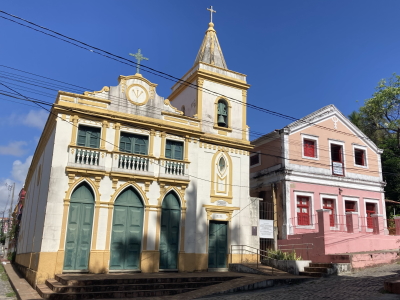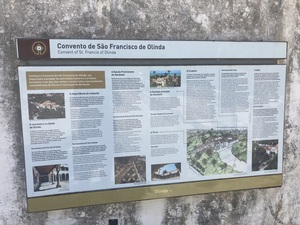Olinda

The Historic Centre of the Town of Olinda has maintained its colonial urban fabric from its heydays when it was a centre of the sugarcane industry.
The town was built on hills overlooking the Atlantic Ocean. It is dominated by rich religious and public buildings, many painted in vivid colours, and includes lots of greenery. Among these are 20 baroque churches, chapels and convents.
Community Perspective: a fairly small, typical Portuguese colonial town. The highlight is the Franciscan convent with its azulejos.
Map of Olinda
Community Reviews
Els Slots

Olinda is your typical cute colonial town, as there are so many in Latin America. Colourful houses, cobblestone streets, adorned with too many churches (Baroque of course!) for its size. I stayed there for 3 nights right in the core zone at the Hotel 7 Colinas, a splurge as I am now halfway through my tour of Brazil. It has lush gardens, a swimming pool, and a decent restaurant.
The town was rebuilt by the Portuguese after the Dutch burned it to the ground in 1630, so most of what you see dates from the late 17th or 18th century. It seems to have no street plan at all: roads are steep, with uneven cobbled stones, and are scattered across the hills. And it is bloody hot!
Buildings here are protected by fences and dogs, a security feature that I only started to notice since arriving in Recife – the North of Brazil that I had experienced so far (from Manaus to Sao Luis and Fernando de Noronha) was very relaxed. A few sketchy people hang about in Olinda’s mostly empty streets (again: hot!), and hawkers will try to sell you a painting or a guided tour of the city. Several of the houses carry a sign that they are for rent during Carnival, a major festival here in Olinda.
I walked around for 2.5 hours in the early morning and I think I have seen most of it. Noteworthy buildings are the Sao Bento Church (1761), the Atlantic Club (1920), and the Observatory (1890). I found the Cathedral disappointing.
The highlight for me however was the Franciscan convent, with its interior walls covered in azulejos depicting both the story of St. Francis and "profane scenes" of noblemen, children, hunters, ships, and fishermen. It also has impressive woodwork at the 17th-century Chapel of the Chapter.
Read more from Els Slots here.
Bojana Bartol
The streets are a real invitation to go back in history and imagine those streets in past centuries. The buildings are well maintained, the streets are safe, and there are extremely hospitable people.
João Aender
Olinda is a town founded during portuguese colonization in northeastern Brazil. It lies only a few kilometers from the capital of the State of Pernambuco, Recife, and has many churches and buildings from the 17th and 18th centuries, all framed by the blue ocean that can be seen from its hilly cobblestone lanes. Olinda reaches its pinnacle during carnival, but all over the year is a charming place to visit.
Olinda was burnt down by the Dutch during their conquest in the 17th century, but has been entirely rebuilt after the Portuguese reconquest and not much has changed since then in its historical centre.
Recife, the neighbour city, has plenty of attractions and also an international airport that make it easier to visit both cities.
Iain Jackson
I visited Olinda in early February 1993. That date will tell those who know Brazil that preparations for Carnival were in full swing. The streets were often blocked by samba bands practicing their routines, some already in full fantastic dress. It was my first stop on my first visit to Brazil (having flown to the adjoining city of Recife from Paris).
The weather was hot and sunny with some scattered cloud.
Olinda was for some time the capital of Pernambuco and, spread out over some small hills, has a considerable number of fine buildings (mostly churches).Many were in desperate need of repair when I was there.
The historic area is not large and a pleasant couple of days can easily be passed wandering through streets of brightly painted houses, visiting the several museums and browsing the many excellent handicraft shops (small highly coloured terra cotta figures a speciality)
Like many Brazilian cities Olinda has a reputation for muggings but apart from a few, easily deterred, would-be guides I received no unwanted attention and much enjoyed my time there which made for a gentle introduction to this vast and diverse country.
Site Info
Site History
1982 Advisory Body overruled
ICOMOS advised Deferral for better comparative analysis and guarantees on rapid urban development of Recife
1982 Inscribed
Site Links
Connections
The site has 21 connections
Art and Architecture
Geography
Human Activity
Individual People
Religion and Belief
Science and Technology
Timeline
Trivia
WHS on Other Lists
Visitors
83 Community Members have visited.
